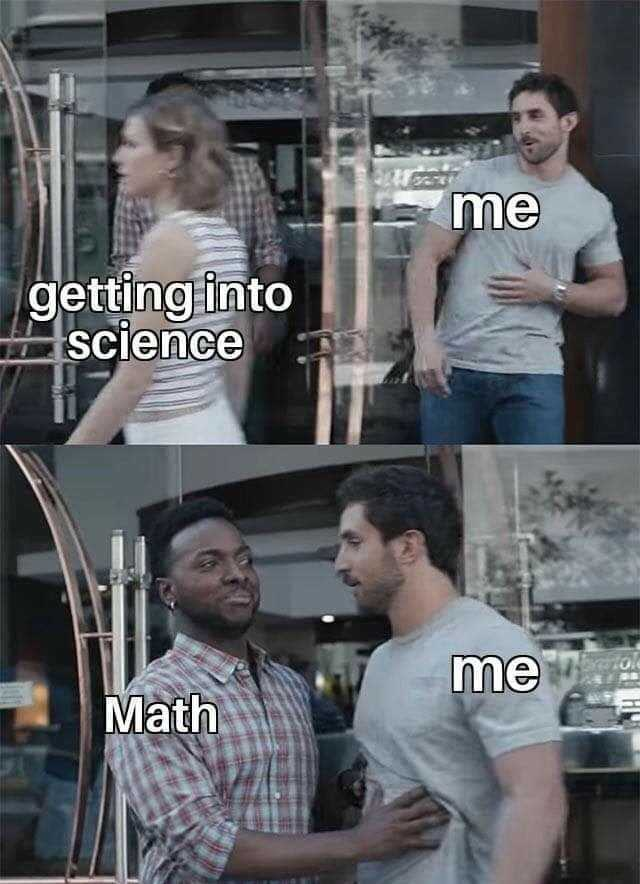
You may have seen this popular meme that suggests a lack of interest in science due to mathematics. It definitely produced a few chuckles and comments on the accuracy of that statement. Even my science friends and math colleagues joined in on the fun. I laughed and then started thinking about it. Why does math stop the interest in science? My overthinking prompted me to research and explore some insights that I will share with you in this blog post.
Interest in STEM
A 2017 survey from the Pew Research Center revealed that most Americans liked science and/or math in school and even considered careers in STEM. Science classes were enjoyed (75%) more than math classes (58%), with 46% of adults saying they liked both science and math. The most cited reason for liking science included hands-on activities. For math, it was the subject matter. This information makes me wonder whether having more hands-on or project-based math activities would increase the affinity for math classes, but that is a question that can be explored at another time.
The same survey found that two-thirds of adults in STEM careers liked both math and science in K-12 schooling, carrying that interest through to the workforce. Among those in non-STEM careers, 45% liked science and math in school but left these fields before entering the workforce. The most interesting statistic is that 40% of those surveyed, who are in non-STEM careers, said that they were “very” or “somewhat” interested in pursuing a career in STEM, with most of them (41%) leaving STEM while in their 20’s or in college.
Why did these initially interested adults leave STEM? Twenty-seven percent cited cost and time barriers, which is logical because most STEM careers require at least a bachelor’s degree. Another 14% cited difficulty with STEM classes or a loss of interest in STEM. It is these populations I want to focus on - those who were interested in STEM but left because of challenges likely arising when in college. What can we, as educators, do to support and encourage those students interested in STEM who are stopped by challenges?
Training for STEM careers

Most STEM careers fall under “professional and related occupations” and require at least a four-year college degree. While all college graduates must meet math requirements at the level of advanced algebra, STEM degrees require calculus. For my undergraduate biochemistry degree, I had to complete statistics and two semesters of calculus. My mechanical engineer husband had to complete several semesters of calculus and math-intensive courses like statics and dynamics.
Many adults regularly use math skills in the workplace. According to the Organization for Economic Co-operation and Development (OECD), 4% of adults use advanced math, and 29% use simple algebra or formulas at least once a week. As a biomedical research scientist, I constantly used algebra and statistics but cannot recall a time where I needed calculus. Likewise, as a practicing engineer, my husband rarely needed to use calculus. Instead, he relied on programs to complete calculations. However, he did need to understand concepts from advanced mathematics like limits, problem-solving processes, and various types of functions. This is why advanced math is, and should continue to be, required for STEM career training.
College math courses as barriers

If you majored in STEM, you’re probably familiar with “weed out”’ courses. These are often introductory courses within a major or that support a major. For example, it’s well known at many institutions, including my alma mater, that first-semester general chemistry is a “weed out” course. First-semester calculus is also often perceived as one because it is foundational for many STEM majors. “Weed out” courses are usually large and lecture-style with a high proportion of D’s, F’s, and withdrawals. They cover a lot of material quickly, and students are often discouraged from asking questions or actively participating due to the class size. These kinds of “weed out” courses can disproportionately prevent minorities and women from continuing in STEM.
There’s a need for more STEM graduates to fill the projected growth in STEM occupations. Having “weed out” courses inhibits students from persisting in STEM, so there is a call to change this culture of “weeding out” students. Much of this culture change rests upon departments and individual instructors. Departments can require a standardization of course objectives and support instructors’ collaboration to create equity across course sections. Within courses, we need not assume that all students are coming in with sufficient background knowledge. Instead, we need to test prerequisite knowledge and invite students who need support to get additional help. Flipping the classroom so in-class time can focus on problem-solving rather than direct instruction can also increase student success.
Promoting social connections within introductory STEM courses can help students endure “weed out” courses. A study published in 2020 revealed that students who completed a values affirmation exercise within their introductory biology course were more likely to feel comfortable in class and interact with their peers. Connecting with like-minded peers gives students the support they need to persist.
Of course, this discussion of “weed out” courses assumes that students interested in STEM can get into these credit-bearing courses in the first place. In a study of California community colleges with student data from 2010 and later, only 40% of students who aspired to be in STEM careers were placed in transfer-level math. The rest were placed in developmental math. This misalignment between math needs and career aspirations can discourage students from continuing in STEM careers. Fortunately, there are now initiatives to place students in credit-bearing math courses and help them be successful. For example, Illinois has high school transitional math, allowing students to be automatically placed into college math. States like Texas, Tennessee, and Kentucky have programs requiring colleges to use corequisite courses to support students.
While we can laugh about the meme of math stopping an interest in science, there’s truth to that statement. Everyone has their own story or reason why they didn’t continue in STEM, and some of them involve barriers that we, as educators, have the power to remove. Placing students in credit-bearing classes, providing support such as corequisite courses, changing the culture of “weed out” courses, and helping students connect with like-minded peers can promote persistence in STEM. Above all, demonstrate to students the practicality and usefulness of mathematics and science, and encourage them to persist in their STEM interest, regardless of perceived barriers like math.

Putting it into Practice: Do you teach introductory STEM courses? Then, you have the power to discourage or encourage students’ continuation in STEM fields. Change the culture of “weed out” courses at your institution, help students connect with others within courses, and provide instructional support that promotes learning.







